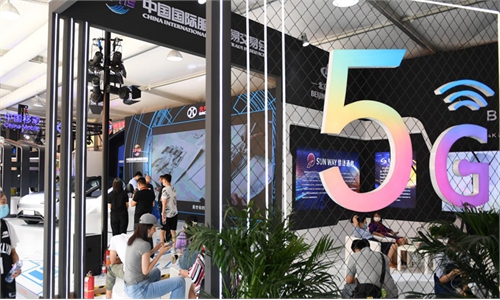COMMENTS / EXPERT ASSESSMENT
To lead in 6G, US, Japan first need to catch up with China in 5G

Illustration: Tang Tengfei/GT
The just-concluded summit between US and Japanese leaders paved the way for cooperation between the two countries in the "Beyond 5G" technology, as they pledged to invest $4.5 billion in 6G technology development. That has prompted some US media outlets to optimistically predict that after joining forces, the two countries will take the lead in the 6G era.Such a goal to return to the top of technology pyramid in the 6G field should be respected. After all, the US and Japan are both technological powers that once enjoyed significant advantages in the 1G and 2G era. However, technological advancements come from concrete efforts rather than media hype. Whether the US and Japan can achieve this goal requires detailed analysis.
First, it's the comprehensive strength of one country that affects its 6G development. The US and Japan think that by joining forces, they can contain China's 6G development, but if they want to take the lead in the 6G, they must gain significant advantages in various aspects, including telecommunication standards, equipment, and network construction.
For instance, the US and Japan seek to build an alliance through the OpenRAN ecosystem, but the establishment of telecommunication standards are led by the International Telecommunication Union (ITU). Even if the US and Japan build an alliance, it's not easy for them to win support from all countries for their standards.
Network construction is the most important capability for any country in the mobile communication field. China has built more than 5.5 million 4G base stations and more than 800,000 5G base stations. In comparison, the US has only built less than 400,000 4G base stations and about 50,000 5G base stations. The big gap has led to completely different market capacity. US and Japanese telecommunication equipment manufacturers have also lost their competitiveness.
In terms of mobile internet businesses, the US and Japan have also lagged behind. While TikTok was achieving great success in the US, local short-video sharing platforms can barely compete with the Chinese app.
In short, in 6G development, the strengths of the US and Japan are not strong enough, and therefore it is quite difficult for them to take the lead when it comes to 6G.
Second, the development of every generation of mobile communication technology is a gradual process. The US and Japan, which led the way in 1G and 2G, have lagged behind in almost every aspect in 4G and 5G. If they want to take the lead in 6G, they must at least catch up with China and be on a par in the 5G era.
Since the dawn of 3G, the US economy has shifted its focus toward a new growth model represented by the internet industry. As large amount of funds and talent flowed into the internet sector, industries that demand larger investments and have slow returns have been sidelined, which cost the US its leading position in the mobile communication sector. A larger number of companies in the US' communication sector have failed. Its network construction has also fallen behind the world's average level. If the US wants to find its place in the sector, it faces serious challenge in technology, talent and market.
Third, before embracing 6G development, the bubble of 5G must be squeezed out. It should be pointed out that one generation of mobile communication's vision will only be achieved fully in the next generation of technology development. The vision of 5G is to connect all things, which still needs technology development in the 6G era to make that happen. Given the bubble in 5G, if a country wants to skip 5G and go straight into 6G, it will only create a new bubble.
The author is director-general of the Beijing-based Information Consumption Alliance. bizopinion@globaltimes.com.cn



